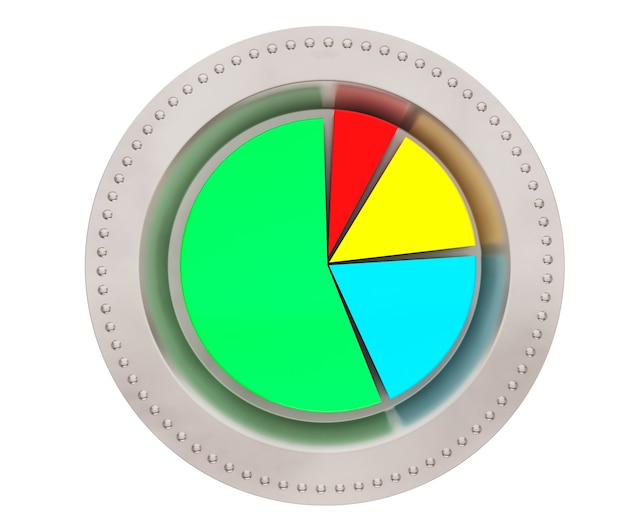Investment Diversification: Optimizing Asset Classes for Financial Success

Investment diversification involves strategically allocating investments across various asset classes to mitigate risk and enhance potential returns, but the optimal number of asset classes depends on individual financial goals, risk tolerance, and investment horizon.
Do you ever wonder if your investment portfolio is truly secure? **Investment diversification: How many asset classes do you need in your financial plan?** This question is crucial for anyone aiming to build long-term financial security and manage risk effectively.
Understanding the Basics of Investment Diversification
Investment diversification is a strategy that aims to reduce risk by allocating investments across different asset classes. It’s based on the principle that not all investments move in the same direction at the same time. By spreading your investments, you can minimize the impact of any single investment’s poor performance on your overall portfolio.
What are Asset Classes?
Asset classes are broad categories of investments that exhibit similar characteristics and behaviors in the marketplace. Common asset classes include stocks, bonds, real estate, and cash. Each asset class has its own unique risk and return profile, making diversification essential for a balanced portfolio.
Why is Diversification Important?
Diversification helps to smooth out investment returns over time. When one asset class is underperforming, others may be doing well, offsetting the losses. This can lead to more stable and predictable returns, reduced volatility, and a greater likelihood of achieving your financial goals. By understanding this, you can confidently approach the nuances of investment diversification: how many asset classes do you need in your financial plan?.
- Mitigates risk by spreading investments across different assets.
- Reduces portfolio volatility during market fluctuations.
- Enhances potential for long-term growth and stable returns.
- Protects against significant losses from individual investment failures.
In essence, diversification is a cornerstone of sound financial planning, providing a buffer against market uncertainties and fostering a more resilient investment strategy.
The Role of Asset Allocation in Portfolio Construction
Asset allocation is the process of deciding how to distribute your investments among various asset classes. It is a critical component of portfolio construction and is tailored to your specific financial goals, risk tolerance, and time horizon. Effective asset allocation can significantly impact your portfolio’s performance.
Aligning Asset Allocation with Financial Goals
Your financial goals should drive your asset allocation decisions. For example, if you’re saving for retirement, you may allocate a larger portion of your portfolio to stocks, which have the potential for higher returns over the long term. If you’re saving for a short-term goal, such as a down payment on a house, you may prefer a more conservative allocation with a higher percentage of bonds and cash.
Assessing Risk Tolerance
Risk tolerance is another key factor in asset allocation. If you’re comfortable with taking on more risk in exchange for potentially higher returns, you may allocate more to stocks. If you’re risk-averse, you may prefer a more conservative allocation with a higher percentage of bonds. It’s important to honestly assess your risk tolerance to create an asset allocation that you can stick with, even during market downturns.

Proper asset allocation and investment diversification: how many asset classes do you need in your financial plan? are not just about balancing risk and return; it’s about aligning your investments with your life goals and comfort levels.
Determining the Optimal Number of Asset Classes
There is no one-size-fits-all answer to the question of how many asset classes you need in your financial plan. The optimal number depends on your individual circumstances. However, a well-diversified portfolio typically includes at least four to five different asset classes to provide a good balance of risk and return.
The Core Asset Classes
The core asset classes that should be included in most diversified portfolios are stocks, bonds, real estate, and cash. Stocks provide growth potential, bonds offer stability and income, real estate provides inflation hedging, and cash offers liquidity and safety.
Adding Additional Asset Classes
Depending on your financial goals and risk tolerance, you may consider adding additional asset classes to your portfolio, such as commodities, alternative investments, or international stocks and bounds. These asset classes can provide further diversification and potentially enhance returns.
- Stocks (Equities): Offer growth potential but come with higher volatility.
- Bonds (Fixed Income): Provide stability and income, typically less volatile than stocks.
- Real Estate: Offers inflation hedging and potential rental income.
- Cash: Provides liquidity and safety, with minimal returns.
The key is to strike a balance between diversification and complexity. Adding too many asset classes can make your portfolio difficult to manage and may not significantly improve its overall risk-adjusted returns.
Exploring Traditional and Alternative Asset Classes
When constructing a diversified investment portfolio, it’s essential to understand the characteristics of both traditional and alternative asset classes. Traditional asset classes include stocks, bonds, and cash, while alternative asset classes encompass a broader range of investments such as real estate, commodities, private equity, and hedge funds.
Traditional Asset Classes: Stocks, Bonds, and Cash
Stocks represent ownership in companies and offer the potential for capital appreciation. Bonds are debt securities that provide a fixed income stream. Cash is the most liquid asset class, providing stability and serving as a safe haven during market downturns. Each play an important role in **investment diversification: how many asset classes do you need in your financial plan?**.
Alternative Asset Classes: Real Estate, Commodities, and More
Alternative asset classes can offer diversification benefits and potentially higher returns, but they also come with increased complexity and risk. Real estate can provide rental income and capital appreciation, while commodities can act as an inflation hedge. Private equity involves investing in privately held companies, and hedge funds employ various investment strategies to generate returns.

Understanding the risk-return profiles of both traditional and alternative asset classes is crucial for making informed investment decisions and constructing a well-diversified portfolio that aligns with your financial goals and risk tolerance.
Balancing Risk and Return with Diversification
One of the primary goals of investment diversification is to balance risk and return. By spreading your investments across different asset classes, you can reduce the overall risk of your portfolio while still maintaining the potential for attractive returns. It’s the main piece of **investment diversification: how many asset classes do you need in your financial plan?**.
Understanding Risk-Return Trade-offs
Different asset classes have different risk-return profiles. Generally, assets with higher potential returns also come with higher risk, and vice versa. Stocks tend to have higher returns and higher volatility compared to bonds, which offer more stability but lower returns. Finding the right balance between risk and return is essential for achieving your financial goals.
Using Diversification to Optimize Portfolio Performance
Diversification allows you to optimize your portfolio’s performance by reducing its volatility. A well-diversified portfolio is less likely to experience significant losses during market downturns, which can help you stay on track toward your financial goals.
- Assess your risk tolerance to determine the appropriate asset allocation.
- Include a mix of asset classes with varying risk-return profiles.
- Regularly rebalance your portfolio to maintain your desired asset allocation.
- Avoid concentrating your investments in a single asset class or sector.
Effective diversification is an ongoing process that requires careful monitoring and adjustment to ensure that your portfolio continues to align with your financial goals and risk tolerance. It’s about making informed choices that protect and grow your wealth over time.
Practical Steps to Implement Diversification in Your Financial Plan
Implementing diversification in your financial plan involves several practical steps, including assessing your financial goals, determining your risk tolerance, selecting asset classes, allocating investments, and regularly rebalancing your portfolio. Let’s delve into these steps.
Assessing Financial Goals and Time Horizon
Your financial goals and time horizon should be the foundation of your investment strategy. Are you saving for retirement, a down payment on a house, or your children’s education? The longer your time horizon, the more risk you can typically afford to take, allowing for a greater allocation to growth assets like stocks. For shorter-term goals, a more conservative approach with a focus on capital preservation may be more appropriate.
Determining Risk Tolerance
Understanding your risk tolerance is crucial for making informed investment decisions. Are you comfortable with the possibility of losing money in exchange for potentially higher returns? Or do you prefer a more conservative approach that prioritizes capital preservation? Your risk tolerance will influence the types of assets you include in your portfolio and the percentage allocated to each asset class.
Selecting Asset Classes and Allocating Investments
Once you’ve assessed your financial goals and risk tolerance, you can begin selecting asset classes and allocating investments. A well-diversified portfolio typically includes stocks, bonds, real estate, and cash. The allocation to each asset class should be based on your individual circumstances and preferences.
Diversifying is not something that comes over night. It requires proper balance and a good understanding of your needs in order to make it work.
| Key Element | Brief Description |
|---|---|
| 🎯 Financial Goals | Align asset allocation with your specific financial objectives. |
| ⚖️ Risk Tolerance | Assess comfort level with potential losses to guide investment choices. |
| 🌱 Asset Classes | Include stocks, bonds, real estate, and cash for a balanced portfolio. |
| 🔄 Rebalancing | Regularly adjust your portfolio to maintain the desired asset allocation. |
Frequently Asked Questions (FAQ)
▼
Diversification reduces risk by spreading investments across different asset classes. This minimizes the impact of any single investment’s poor performance on the overall portfolio.
▼
The main asset classes include stocks (equities), bonds (fixed income), real estate, and cash. Each has its own risk and return characteristics.
▼
Assess your comfort level with potential investment losses. If you’re risk-averse, allocate more to stable assets like bonds and cash.
▼
Asset allocation is the process of dividing your investments among different asset classes to balance risk and potential returns based on your goals.
▼
Rebalance your portfolio at least annually or when your asset allocation deviates significantly from your target. This helps maintain your desired risk level.
Conclusion
Ultimately, **investment diversification: how many asset classes do you need in your financial plan?** requires a balanced approach tailored to individual financial goals, risk tolerance and investment horizon, where aligning diverse assets while remaining flexible, guarantees a well-rounded portfolio positioned for long-term growth.





